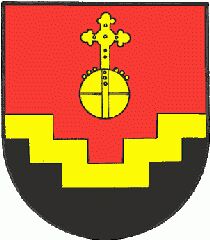Veitsch: Difference between revisions
Knorrepoes (talk | contribs) m (Text replace - "Österreich" />" />" to "Österreich" />") |
Knorrepoes (talk | contribs) m (Text replace - "[[Literature" to "{{media}} [[Literature") |
||
| Line 18: | Line 18: | ||
There are surface mines for magnesite in the municipality; the steps in the arms represent the mining sites. The orb is an attribute of St. Veit (St. Vitus), one of the patron saints of the Holy Roman Empire. He is also the patron saint of the Veitsch church. | There are surface mines for magnesite in the municipality; the steps in the arms represent the mining sites. The orb is an attribute of St. Veit (St. Vitus), one of the patron saints of the Holy Roman Empire. He is also the patron saint of the Veitsch church. | ||
{{media}} | |||
[[Literature]] : Image provided by Karl Palfrader (k.palfrader@aon.at), MStLA 31 (1981), p. 38 | [[Literature]] : Image provided by Karl Palfrader (k.palfrader@aon.at), MStLA 31 (1981), p. 38 | ||
Revision as of 07:49, 9 July 2014
| Heraldry of the World Civic heraldry of Austria - Österreichische Gemeindewappen |
VEITSCH
State : Steiermark
District : Mürzzuschlag
Origin/meaning
The arms were granted on December 15, 1980.
In the Middle Ages, Veitsch was property of the Holy Roman Empire (Reichsgut). Later on, it passed to the Benedictine abbey of St. Lambrecht. With regard to this, the arms was designed in the tinctures of or and sable (gold and black) as in the arms of the Holy Roman Empire and or and gules (gold and red) as in the abbey arms.
There are surface mines for magnesite in the municipality; the steps in the arms represent the mining sites. The orb is an attribute of St. Veit (St. Vitus), one of the patron saints of the Holy Roman Empire. He is also the patron saint of the Veitsch church.
Contact and Support
Partners:
Your logo here ?
Contact us
© since 1995, Heraldry of the World, Ralf Hartemink 
Index of the site
Literature : Image provided by Karl Palfrader (k.palfrader@aon.at), MStLA 31 (1981), p. 38











